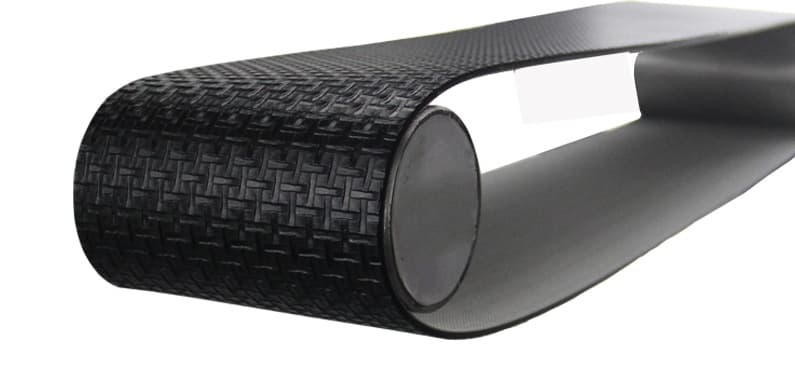
Home Products Rubber Part General Rubber Fittings Rubber Conveyor Belt
Description:
 The rubber conveyor belt is also called the conveyor belt. It is a rubber, fiber, metal composite product, or a plastic and fabric composite product used to carry and transport materials in the belt conveyor belt; it is the main component of the belt conveyor. The conveyor belt is mainly composed of three parts: the skeleton material, the covering layer and the base material, among which the covering layer is the key part that determines its performance and use. According to the different raw materials used in the covering layer, the conveyor belt industry can be classified into two categories: heavy-duty conveyor belts and light-duty conveyor belts. The former uses rubber (including natural rubber and synthetic rubber) as the main raw material, so it is also called rubber conveyor belt. Its use The scope is concentrated in the fields of heavy industry and infrastructure construction; the latter mainly uses polymer materials, which are mainly used in light industries such as food and electronics. Belt conveyors are widely used in agriculture, industrial and mining enterprises, and transportation industries to transport various solid block and powder materials or finished items, and the conveyor belt can be transported continuously, efficiently, and at a large inclination angle. At the same time, the conveyor belt It is safe in operation, easy to use and maintain, low in freight, can shorten the transportation distance, reduce the project cost, and save manpower and material resources.
The rubber conveyor belt is also called the conveyor belt. It is a rubber, fiber, metal composite product, or a plastic and fabric composite product used to carry and transport materials in the belt conveyor belt; it is the main component of the belt conveyor. The conveyor belt is mainly composed of three parts: the skeleton material, the covering layer and the base material, among which the covering layer is the key part that determines its performance and use. According to the different raw materials used in the covering layer, the conveyor belt industry can be classified into two categories: heavy-duty conveyor belts and light-duty conveyor belts. The former uses rubber (including natural rubber and synthetic rubber) as the main raw material, so it is also called rubber conveyor belt. Its use The scope is concentrated in the fields of heavy industry and infrastructure construction; the latter mainly uses polymer materials, which are mainly used in light industries such as food and electronics. Belt conveyors are widely used in agriculture, industrial and mining enterprises, and transportation industries to transport various solid block and powder materials or finished items, and the conveyor belt can be transported continuously, efficiently, and at a large inclination angle. At the same time, the conveyor belt It is safe in operation, easy to use and maintain, low in freight, can shorten the transportation distance, reduce the project cost, and save manpower and material resources.
Classification
According to different use environments, it can be classified into heavy-duty conveyor belts and light-duty conveyor belts.
According to different uses, it can be classified into lifting belts, power belts, and conveyor belts.
According to different structures, it can be classified into ordinary laminated type, impact-resistant and tear-resistant type with transverse reinforcement layer.
According to the performance of the covering rubber, it is classified into ordinary conveyor belts, heat-resistant conveyor belts, high-temperature-resistant conveyor belts, burning-resistant conveyor belts, cold-resistant conveyor belts, acid-resistant conveyor belts, alkali-resistant conveyor belts, and oil-resistant conveyor belts. Belts, wear-resistant conveyor belts, static-conductive conveyor belts, food-type conveyor belts, etc.
Application
Metallurgy, iron and steel, coal, casting, hydropower, building materials, chemicals, food;
Logistics, post, tobacco, paper industry, printing, textile, wood industry, packaging, electronics, instrumentation, fitness equipment;
Mines, airports, ports, power plants, steel mills, granaries;
Technical Standards
|
Grade |
Standard |
Breaking Strength |
Elongation at Break |
Abrasion |
|
|
|
W |
DIN22102 |
18 |
400 |
90 |
||
|
X |
DIN22102 |
25 |
450 |
120 |
||
|
Y |
DIN22102 |
20 |
400 |
150 |
||
|
Z |
DIN22102 |
15 |
350 |
250 |
||
|
V |
DIN22102 |
15 |
350 |
200 |
||
|
H |
ISO15236 |
24 |
450 |
120 |
||
|
D |
ISO15236 |
18 |
400 |
100 |
||
|
L |
ISO15236 |
15 |
350 |
200 |
||
|
K |
ISO15236 |
15 |
350 |
200 |
||
|
A |
AS1332 |
17 |
400 |
70 |
||
|
E |
AS1332 |
14 |
300 |
/ |
||
|
F |
AS1332 |
14 |
300 |
/ |
||
|
M |
AS1332 |
24 |
450 |
125 |
||
|
N |
AS1332 |
17 |
400 |
200 |
||
|
S |
AS1332 |
14 |
300 |
250 |
||
|
Ⅰ |
RMA |
17 |
400 |
/ |
||
|
Ⅱ |
RMA |
14 |
400 |
/ |
||
|
1 |
ARPM |
17 |
400 |
125 |
||
|
2 |
ARPM |
14 |
400 |
175 |
Name: Alex Zhang
Mobile:+86 13171716031
Whatsapp:8613171716031
Email:alex@ovictors.com
Name: Tex
Whatsapp:8618310003967
Email:tex@ovictors.com
Name: Lisa
Whatsapp:8618330856285
Email:info@ovictors.com
Add:Tengda East 7#,Qianjin Street,Hengshui,053000,Hebei,China.